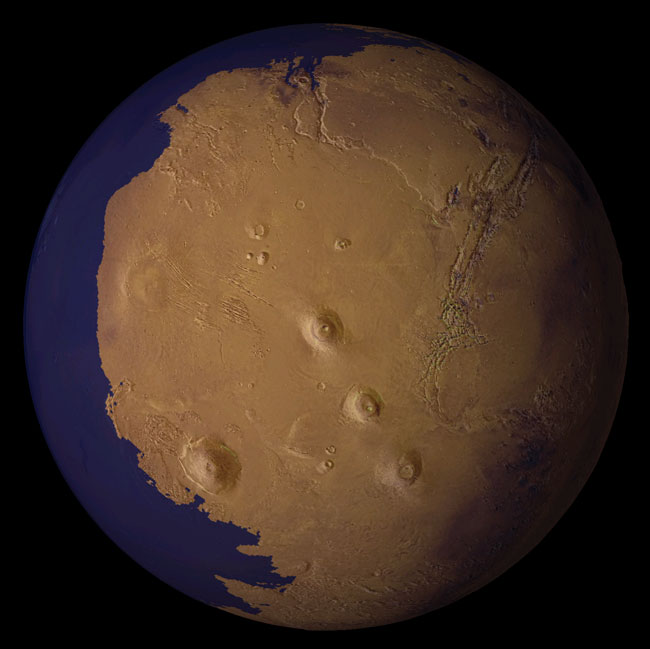| Tweet |

20億年以上前、火星の北極付近はこのように大洋の海水で覆われていたようだ(Credit: Taylor Perron/UC Berkeley)
**********************************
カリフォルニア大学バークレー校の天文学者、Mark RichardsとTaylor Perronは、6月14日発行の「ネイチャー」誌に、かつて火星には広大な大洋が存在したことが証明されたとする論文を発表した。
1991年以来、火星の北極付近に古い海岸線のようなものが見られることから、火星の約3分の1は大洋であったのではないかという説をめぐって、論争が続けられてきたが、今回の二人の論文は、これに終止符を打った形となった。
彼らによれば、北極付近のArabia Oceanに見られる古い海岸線とDeuteronilus Oceanに見られる新しい海岸線により、「Arabiaの方には、南極大陸の氷の2−3倍の水量の大洋が存在したようだ」とのこと。
http://www.livescience.com/space/scienceastronomy/070613_mars_oceans.html
Mystery Solved: Mars Had Large Oceans
By Dave Mosher
posted: 13 June 2007 01:00 pm ET
Since 1991, planetary scientists have floated the idea that Mars once harbored vast oceans that covered roughly one-third of the planet. Two long shore-like lips of rock in the planet's northern hemisphere were thought to be the best evidence, but experts argued that they were too "hilly" to describe the smooth edges of ancient oceans.
The view just changed dramatically with a surprisingly simple breakthrough.
The once-flat shorelines were disfigured by a massive toppling over of the planet, scientists announced today. The warping of the Martian rock has hidden clear evidence of the oceans, which in any case have been gone for at least 2 billion years.
"This really confirms that there was an ocean on Mars," said Mark Richards, a planetary scientist at the University of California at Berkeley and co-author of the study, which is detailed in the June 14 issue of the journal Nature.
Twin shores
Two major shorelines exist on Mars, each thousands of miles long--one remaining from the older Arabia Ocean, and another from the younger Deuteronilus Ocean, said study co-author Taylor Perron of UC Berkeley.
"The Arabia would have contained two to three times the volume of water than in the ice that covers Antarctica," Perron told SPACE.com.
Somewhere along the way to toppling over 50 degrees to the north, Mars probably lost some of its water, leaving the Deuteronilus Ocean's shoreline exposed. "The volume of water was too large to simply evaporate into space, so we think there is still some subterranean reservoirs on Mars," Perron said.
The remaining sea would have been located in the same lowland plain as the Arabia Ocean, but almost 40 degrees to the north.
Unstable spin
As a planet spins, the heaviest things tend to shift towards the equator, where they are most stable. Earth, too, has a bulge at its equator. The volcanic Tharsis region of Mars, a vast raised area along Mars' equator, is evidence for how this works.
"This is the reason why this discovery packs extra punch," Perron said. More than a billion years ago, he explained, something happened in the way mass was distributed on Mars to cause the imbalanced portion to shift toward the equator--and allow the vast shores of the Martian oceans to warp.
"We found evidence of the path the shift would have to have occurred, and it matches with the deformation of the shorelines," Perron said.
Elastic surface
Near the equator, the surface of a planet stays in a relatively flattened bulge under the pressure of centripetal forces. But outside of the equator, the rock behaves elastically and often bunches up, like the surface of a deflating balloon. Perron and his team reasoned that the oceanic shorelines were once near the equator, but warped into hilly up-and-down elevations of rock as they move towards the north with the tilting planet.
"On planets like Mars and Earth that have an outer shell ... that behaves elastically, the solid surface will deform," Richards said.
By calculating the deformation, which occurs in a predictable way, the planetary research team found the ridges had to have once been flat, like ocean shorelines.
"This is a beautiful result that Taylor [Perron] got," Richards said. "The mere fact that you can explain a good fraction of the information about the shorelines with such a simple model is just amazing. It's something I never would have guessed at the outset."
Perron and his colleagues aren't certain what caused the toppling of the planet, but they think forces beneath the surface are to blame. "There could have been a massive change in the distribution of mantle," Perron said, "which would have caused the planet to shift into its current position."
▲このページのTOPへ HOME > 環境・エネルギー・天文板2掲示板
フォローアップ:
投稿コメント全ログ コメント即時配信 スレ建て依頼 削除コメント確認方法
 題名には必ず「阿修羅さんへ」と記述してください。
題名には必ず「阿修羅さんへ」と記述してください。
掲示板,MLを含むこのサイトすべての
一切の引用、転載、リンクを許可いたします。確認メールは不要です。
引用元リンクを表示してください。